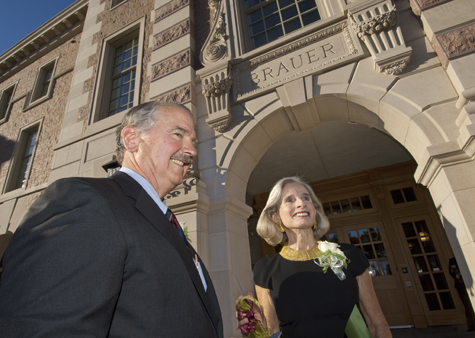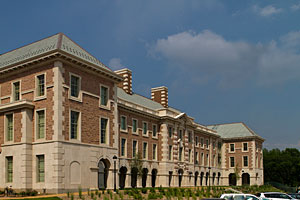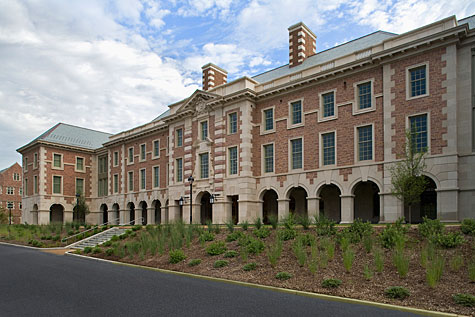
Stephen F. & Camilla T. Brauer Hall, the second building in a new engineering complex at Washington University in St. Louis, was dedicated in a ceremony held Friday, Oct. 1.
The building, which is named in honor of Stephen F. and Camilla T. Brauer, is home to the Department of Energy, Environmental & Chemical Engineering (EECE) and includes space for the Department of Biomedical Engineering (BME) and the dean’s office.
Participating in the ceremony were Stephen F. Brauer, chair of Washington University’s Board of Trustees, and Camilla T. Brauer; John F. McDonnell, vice chair of the Board of Trustees; David W. Kemper, vice chair of the Board of Trustees; Chancellor Mark S. Wrighton; Ralph S. Quatrano, PhD, dean of the School of Engineering & Applied Science; and Melissa L. Holtmeyer, doctoral candidate in the Department of Energy, Environmental & Chemical Engineering and student representative to the Board of Trustees.
“Thanks to Steve and Kimmy Brauer and the other donors, the engineering faculty and students now have additional state-of-the-art facilities to pursue interdisciplinary research in collaboration with colleagues in the physical, biological and medical sciences,” Quatrano said.
“So many of today’s important research challenges and questions exist at the interfaces between engineering and other disciplines,” Quatrano said. “Brauer Hall will be the hub for new ideas, a place for advancing innovative theories and the focal point for research that will lead us to a healthier, more sustainable and cleaner planet.
“Brauer Hall will enable us to attract and retain the best and brightest students and the most talented faculty, and it will provide them with the tools they need to do great work,” Quatrano said.
The dedication was followed by a reception in Brauer Hall and a private dinner, where the keynote speaker was John P. Holdren, PhD, who was appointed by President Barack Obama as assistant to the president for science and technology and director of the White House Office of Science and Technology.
The dedication took place during a symposium on global energy future hosted by the McDonnell International Scholars Academy and its Global Energy and Environmental Partnership, a consortium of 25 international universities and Washington University that work collaboratively on energy, environmental and sustainability research initiatives. Among the delegates to the symposium were the presidents of the partnering universities in the academy.

‘A living laboratory’
Pratim Biswas, PhD, the Stifel and Quinette Jens Professor of Environmental Engineering Science, chair of the EECE department and director of the McDonnell Academy Global Energy and Environmental Partnership, pointed out that energy and the environment are global challenges.
“Brauer Hall will be a living laboratory for energy efficiency and environmental projects,” Biswas said. “Students and visitors will be able to see for themselves the application of knowledge to green building activities. Our hope is that this building will serve as a beacon for energy efficiency and energy sustainability for years to come.”
The 150,875-square-foot building is located at the northeast corner of the Danforth Campus. Construction began in October 2008 and was completed in April 2010. Faculty and staff moved in during the summer, and classes were held in the building for the first time in August.
Brauer Hall includes state-of-the-art laboratories, including 21 wet laboratories, four dry laboratories and two teaching laboratories; a distance-learning classroom that will allow WUSTL researchers and students to hold real-time meetings via the Internet with their counterparts at partner institutions; instrumentation and imaging facilities; and electronically equipped collaboration points in the halls near the labs.
“One of the best parts of this building,” Holtmeyer said during the dedication ceremony, “is the openness that you find everywhere. Interaction with other students and professors is a very important aspect of research. Here at Brauer Hall, that interaction is made easy. The collaboration areas in the halls are already freqeuntly used for ad-hoc gatherings and information discussions for those time when you just need someone else to bounce some ideas off of.
“Brauer Hall is everything it was promised to be,” Holtmeyer said. “It is state-of-the-art all the way, a place where we can work at the cutting edge of research and development.
“It is a place where we can discover new techniques and solutions that may one day solve our nation’s energy problems or result in a better prosthetic device for someone in need. It is a place where you are just as likely to run into a professor from China or a leading geneticist from our med school as you are an engineering student from Washington, Mo., like me,” Holtmeyer said.
The three-story building, which includes many other innovative features, has received LEED Gold certification.
LEED, the acronym for Leadership in Energy and Environmental Design, is a nationally accepted rating system for environmental sustainability developed by the U.S. Green Building Council. Gold is the second-highest rating in the system.
Among the building’s innovations are solar panels, a wind turbine (on the building’s northeast corner), a reflective roof to minimize heat gain, low-flow restroom fixtures, and low-energy lighting systems. Recycled jeans were used for insulation in the walls.
An abandoned brick-lined sewer pipe located in front of the building was converted to an underground cistern that holds rainwater used to irrigate native plants around the building.

Energy- and resource-use meters are integrated with two smartboard systems, one in a teaching lab and one in the lobby’s atrium, that allow visitors to see how efficiently the building is running.
The touch-screen dashboard on the smartboard in the atrium allows a visitor to display the electrical energy used, the energy generated by solar panels, the amount of water consumed, and other variables.
The dashboard, which communicates with the Internet, also can be viewed remotely.
Brauer Hall was designed by the architectural firm RMJM, which was chosen because it specializes in laboratory design and historic preservation, and constructed by St. Louis-based Clayco Inc.
The university received a major commitment from the Brauers to help implement the long-range, strategic plan of its School of Engineering & Applied Science.
The Brauers
Stephen Brauer, chair of the Board of Trustees and chair of the National Council for the School of Engineering & Applied Science, joined the Board of Trustees in 1991. He has championed the goal of accelerating Washington University’s ascent among the world’s premier universities and building a leading engineering school.
The company Brauer heads, Hunter Engineering, was founded by his late stepfather, Lee Hunter, an automotive engineer — and Automotive Hall of Fame inductee — famous for his inventions, which revolutionized the automotive service industry.
A native St. Louisan, Lee Hunter attended WUSTL, served on the School of Engineering & Applied Science Task Force in the 1980s and was a member of the Board of Trustees from 1982 until his death in 1986.
Brauer started with Hunter Engineering in 1971 after serving three years in the U.S. Army Corps of Engineers. He became president in 1980.
In the past 30 years, Hunter Engineering has achieved remarkable growth through research and new product development. In the area of machine vision technology, in particular, Hunter has collaborated with Joseph O’Sullivan, PhD, the Samuel C. Sachs Professor of Electrical Engineering, among others, to bring that technology to the field of measuring vehicle suspension and alignment.
From 2001-03, Brauer served as U.S. ambassador to Belgium. Upon returning to the United States, he resumed his position at Hunter Engineering.
He is past president of the Missouri Botanical Garden Board of Trustees; a partner in The St. Louis Cardinals Baseball LP; a member of St. Louis Civic Progress; and a director of Ameren.
His long association with the university began in 1987 when he joined the National Council for the School of Engineering & Applied Science. He was appointed to the university’s Board of Trustees in 1991.

Camilla Brauer is a cultural and civic leader. She serves as vice chair of the United Way of Greater St. Louis and has chaired five Alexis de Tocqueville Society campaigns.
She has served as a program chair for the Washington University William Greenleaf Eliot Society and is a founding member of the Danforth Circle committee. The National Society of Fund Raising Executives recognized her in 1996 as the top volunteer fundraiser in the United States.
The Brauers are long-standing members of the Eliot Society and are sustaining charter members of the Danforth Circle. They have provided significant support for student scholarships in the School of Engineering & Applied Science and in the Olin Business School.
They endowed the Stephen F. & Camilla T. Brauer Distinguished Professorship in Biomedical Engineering and have contributed generously to support several university initiatives.
“Brauer Hall reflects the long-standing commitment and vision that Steve and Kimmy Brauer have for Washington University,” Wrighton said. “This remarkable addition to the School of Engineering & Applied Science is not only a prominent addition to the campus of Washington University, but is also a critical research and teaching facility — one that will contribute to the development of new knowledge in both biomedical engineering and energy, environmental, and chemical engineering.”

The facade of Brauer Hall as seen from the south. For a high resolution version of this photograph, click here.